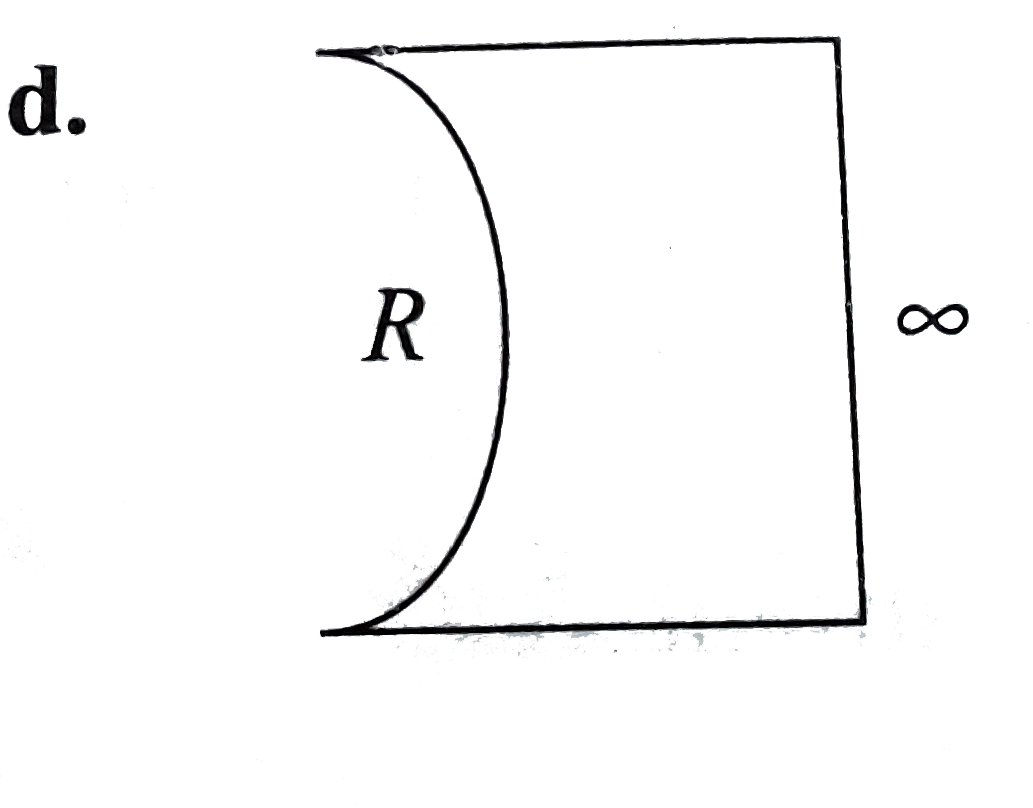Which one of the following sperical lenses does not exhibit dispersion? The radii of curvature of the surfaces of the lenses are as given in the diagrams.
R1≠R2




The correct Answer is:C
To determine which spherical lens does not exhibit dispersion, we need to analyze the conditions under which dispersion occurs in lenses.
1. Understanding Dispersion:
Dispersion in optics refers to the phenomenon where different wavelengths of light are refracted by different amounts when passing through a lens. This typically occurs in lenses where the radii of curvature of the two surfaces are different.
2. Condition for Dispersion:
The key condition for a lens to exhibit dispersion is that the radii of curvature of its two surfaces must not be equal. Mathematically, this can be expressed as:
- If R1≠R2, then dispersion occurs.
3. Analyzing the Given Lenses:
We are provided with different lenses, and we need to check the radii of curvature for each:
- For Lens A: R1 and R2 are different.
- For Lens B: R1 and R2 are different.
- For Lens C: R1=R2 (this is the case we are looking for).
- For Lens D: R1 and R2 are different.
4. Conclusion:
Since Lens C is the only lens where R1 is equal to R2, it does not exhibit dispersion. Therefore, the correct answer is:
- Lens C does not exhibit dispersion.
Final Answer:
The spherical lens that does not exhibit dispersion is Lens C.
Dispersion in optics refers to the phenomenon where different wavelengths of light are refracted by different amounts when passing through a lens. This typically occurs in lenses where the radii of curvature of the two surfaces are different.
The key condition for a lens to exhibit dispersion is that the radii of curvature of its two surfaces must not be equal. Mathematically, this can be expressed as:
- If R1≠R2, then dispersion occurs.
We are provided with different lenses, and we need to check the radii of curvature for each:
- For Lens A: R1 and R2 are different.
- For Lens B: R1 and R2 are different.
- For Lens C: R1=R2 (this is the case we are looking for).
- For Lens D: R1 and R2 are different.
Since Lens C is the only lens where R1 is equal to R2, it does not exhibit dispersion. Therefore, the correct answer is:
- Lens C does not exhibit dispersion.
The spherical lens that does not exhibit dispersion is Lens C.
Topper's Solved these Questions
- GEOMETRICAL OPTICSBOOK - CENGAGE PHYSICS ENGLISHCHAPTER - GEOMETRICAL OPTICSEXERCISE - Multiple Correct Answers Type
8 Videos
- GEOMETRICAL OPTICSBOOK - CENGAGE PHYSICS ENGLISHCHAPTER - GEOMETRICAL OPTICSEXERCISE - Assertion-Reasoninig Type
2 Videos
- GEOMETRICAL OPTICSBOOK - CENGAGE PHYSICS ENGLISHCHAPTER - GEOMETRICAL OPTICSEXERCISE - True/False
5 Videos
- ELECTRON,PHONTS,PHOTOELECTRIC EFFECT & X-RAYSBOOK - CENGAGE PHYSICS ENGLISHCHAPTER - ELECTRON,PHONTS,PHOTOELECTRIC EFFECT & X-RAYSEXERCISE - dpp 3.3
15 Videos
- HEATING EFFECT OF CURRENTBOOK - CENGAGE PHYSICS ENGLISHCHAPTER - HEATING EFFECT OF CURRENTEXERCISE - Thermal Power in Resistance Connected in Circuit
27 Videos
Similar Questions
Which one of the following complexes does not exhibit chirality?
View SolutionWhich one of the following does not exhibit the phenomenon of mutarotation ?
View SolutionFind the focal length of the lens shown in Fig . The radii of curvature of both the surfaces are equal to R.

View SolutionIf R1andR2 are the radii of curvature of the spherical surfaces of a thin lens and R1>R2, then this lens can

View SolutionThree diagrams are given each has equal radial of curvature of the curved surfaces. All the lenses have refractive index μ=1.5.

The ratio of focal lengths of P,Q,R is
View SolutionThe effective focal length of the lens combination shown in figure is -60 cm. The radius of curvature of the curved surfaces of the plano-convex lenses are 12 cm each and refractive index of the material of the lens is 1.5. The refractive index of the liquid is

View SolutionA plano-convex lens fits exactly into a plano-concave lens. Their plane surfaces are parallel to each other. If the lenses are made of different material of refractive indices μ1 and μ2 and R is the radius of curvature of the curved surface of the lenses, then focal length of the combination is
View SolutionA thin plano-convex lens fits exactly into a thin plano-concave lens. Their plane surfaces are parallel to each other. The lenses are made of different material of refractive indices μ1 and μ2 and R is the radius of curvature of the curved surfaces of the lenses, if rays are incident parallel to principal axis on lens of refractive index.
View SolutionTwo thin symmetrical lenses of different nature and of different material have equal radii of curvature R=15cm. The lenses are put close together and immersed in water (μw=43). The focal length of the system in water is 30 cm. The difference between refractive indices of the two lenses is
View SolutionA plano convex lens fits exactly into a plano concave lens. Their plane surfaces are parallel to each other. If the lenses are made of different materials refractive indices μ1 and μ2 and R is the radius curvature of the curved surface of the lenses, the focal length of the combination is
View Solution
